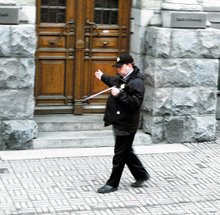The title of the document is: Guide for the Selection of Commercial Explosives Detection Systems for Law Enforcement Applications (NIJ Guide 100-99).
Pages 71-72 of the report include the following section:
http://www.ojp.usdoj.gov/nij/pubs-sum/178913.htm
7. WARNING: DO NOT BUY BOGUS EXPLOSIVES DETECTION EQUIPMENT
From time to time, there are new devices that enter the market. Most companies make reasonable claims, and their products are based on solid scientific principles. Claims for some other devices may seem unreasonable or may not appear to be based on solid scientific principles. An old truism that continues to offer good advise is "If it sounds too good to be true, it probably is not true." If there are any questions as to the validity of a device, caution should be used and thorough research must be performed before a purchase is made. Money can be wasted and even lives may be risked. Although there may be other types of nonoperational devices around, dowsing devices for explosives detection have emerged during the past couple of years.
There is a rather large community of people around the world that believes in dowsing: the ancient practice of using forked sticks, swinging rods, and pendulums to look for underground water and other materials. These people believe that many types of materials can be located using a variety of dowsing methods. Dowsers claim that the dowsing device will respond to any buried anomalies, and years of practice are needed to use the device with discrimination (the ability to cause the device to respond to only those materials being sought). Modern dowsers have been developing various new methods to add discrimination to their devices. These new methods include molecular frequency discrimination (MFD) and harmonic induction discrimination (HID). MFD has taken the form of everything from placing a xerox copy of a Poloroid photograph of the desired material into the handle of the device, to using dowsing rods in conjunction with frequency generation electronics (function generators). None of these attempts to create devices that can detect specific materials such as explosives (or any materials for that matter) have been proven successful in controlled double-blind scientific tests. In fact, all testing of these inventions has shown these devices to perform no better than random chance.
Mostly these devices are used to locate water and now are used extensively by treasure hunters looking for gold and silver. In recent years some makers of these dowsing devices have attempted to cross over from treasure hunting to the areas of contraband detection, search and rescue, and law enforcement. The Quadro Tracker is one notable example of this cross-over attempt. This device was advertised as being a serious technology with a realistic sounding description of how it worked (close examination showed serious errors in the scientific sounding description). Fortunately, the National Institute of Justice investigated this company and stopped the sale of this device for these purposes, but not before many law enforcement agencies and school districts wasted public funds on the purchase of these devices.
Things to look for when dealing with "new technologies" that may well be a dowsing device are words like molecular frequency discrimination, harmonic induction discrimination, and claims of detecting small objects at large distances. Many of these devices require no power to operate (most real technology requires power). Suspect any device that uses a swinging rod that is held nearly level, pivots freely and "indicates" the material being sought by pointing at it. Any device that uses a pendulum that swings in different shaped paths to indicate its response should also arouse suspicion. Advertisements that feature several testimonials by "satisfied users," and statements about pending tests by scientific and regulatory agencies (but have just not happened yet) may be indications that the device has not been proven to work. Statements that the device must be held by a human to operate usually indicate dowsing devices. Statements that the device requires extensive training by the factory, the device is difficult to use, and not everyone can use the device, are often made to allow the manufacturer a way of blaming the operator for the device’s failure to work. Another often used diversion is that scientists and engineers cannot understand the operation of the device or the device operates on principles that have been lost or forgotten by the scientific community.
In general, any legitimate manufacturer of contraband detection equipment will eagerly seek evaluation of their device’s performance by scientific and engineering laboratories. Any doubt that a device is legitimate can quickly be dispelled by making a call to any of the known agencies whose business it is to know about security-related technology.
----
Emphasis in original, in fact it is both bolded and underlined.
According to the TASC Ltd. website, "Sniffex® does not tell the operator the type of explosive detected. The device is easy to work with and light to carry. It operates when interacting with the human hand and slowly moving operator." The Sniffex rod must be held by a human hand to operate and does not require batteries or a power source other than the human body. Does this sound similar to the description of a dowsing rod as described by the National Institute of Justice?

